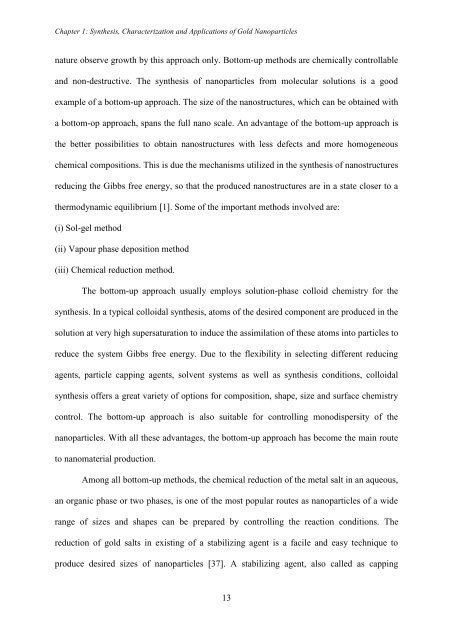PHYS01200704032 Debes Ray - Homi Bhabha National Institute
PHYS01200704032 Debes Ray - Homi Bhabha National Institute
PHYS01200704032 Debes Ray - Homi Bhabha National Institute
Create successful ePaper yourself
Turn your PDF publications into a flip-book with our unique Google optimized e-Paper software.
Chapter 1: Synthesis, Characterization and Applications of Gold Nanoparticles<br />
nature observe growth by this approach only. Bottom-up methods are chemically controllable<br />
and non-destructive. The synthesis of nanoparticles from molecular solutions is a good<br />
example of a bottom-up approach. The size of the nanostructures, which can be obtained with<br />
a bottom-op approach, spans the full nano scale. An advantage of the bottom-up approach is<br />
the better possibilities to obtain nanostructures with less defects and more homogeneous<br />
chemical compositions. This is due the mechanisms utilized in the synthesis of nanostructures<br />
reducing the Gibbs free energy, so that the produced nanostructures are in a state closer to a<br />
thermodynamic equilibrium [1]. Some of the important methods involved are:<br />
(i) Sol-gel method<br />
(ii) Vapour phase deposition method<br />
(iii) Chemical reduction method.<br />
The bottom-up approach usually employs solution-phase colloid chemistry for the<br />
synthesis. In a typical colloidal synthesis, atoms of the desired component are produced in the<br />
solution at very high supersaturation to induce the assimilation of these atoms into particles to<br />
reduce the system Gibbs free energy. Due to the flexibility in selecting different reducing<br />
agents, particle capping agents, solvent systems as well as synthesis conditions, colloidal<br />
synthesis offers a great variety of options for composition, shape, size and surface chemistry<br />
control. The bottom-up approach is also suitable for controlling monodispersity of the<br />
nanoparticles. With all these advantages, the bottom-up approach has become the main route<br />
to nanomaterial production.<br />
Among all bottom-up methods, the chemical reduction of the metal salt in an aqueous,<br />
an organic phase or two phases, is one of the most popular routes as nanoparticles of a wide<br />
range of sizes and shapes can be prepared by controlling the reaction conditions. The<br />
reduction of gold salts in existing of a stabilizing agent is a facile and easy technique to<br />
produce desired sizes of nanoparticles [37]. A stabilizing agent, also called as capping<br />
13

















